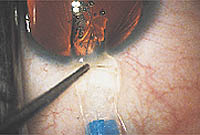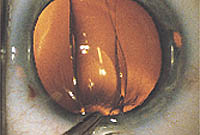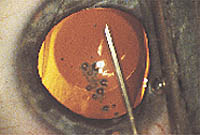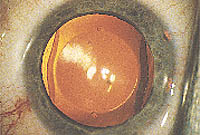Short-term data on ICL are favorable
Outcomes for the hyperopes are similar to those for the myopes.
NEW YORK — Early data from U.S. clinical studies of STAAR Surgical’s (Monrovia, Calif.) Intraocular Contact Lens (ICL) for myopia and hyperopia indicate that so far the lens is safe, predictable and effective, according to David C. Brown, MD. Dr. Brown reported on data from the Food and Drug Administration (FDA) trials at the annual Ocular Surgery News Symposium on Cataract, Refractive and Glaucoma Surgery here. “We are seeing similar outcomes for the hyperopes as for the myopes,” Dr. Brown said. “The predictability is excellent, the ICLs are very safe, and the efficacy is at 80% of patients at 20/40 or better postoperatively.”
The initial myopia study began in February 1997; since then, investigators have continued accumulating data on both hyperopic and myopic eyes. At present, phase 3 enrollment is completed, and the follow-up is ongoing. “Very shortly we will have 3 year data on some of these patients,” Dr. Brown said.
Trial outcomes
The original inclusion criteria for myopic patients were 7 D to 20 D of myopia with 2.5 D of cylinder or less. “We chose younger patients so that we could avoid encountering people with cataracts,” Dr. Brown said, “because the FDA is very concerned about the possibility of inducing cataracts in this group of patients.” Study patients had an average refractive error of 10.2 D, 35% of patients were male, and 65% were female.
The final uncorrected visual acuity in myopic patients was 20/20 for 41% and 20/25 for 36%, with a total of 77% of patients seeing 20/25 or better 1 month postop. “When you examine one of these patients, if the pupil is not dilated and you did not notice the little iridotomies, [the ICL] would hardly be noticeable in the eye,” Dr. Brown said.
Adverse events included one ICL removal because the lens was too long; one line lost in a case of worsening myopic degeneration; and one non-visually significant cataract. “Cataracts are not showing up to be a problem with these lenses,” Dr. Brown said.
The profile for hyperopic patients was similar, he said. Hyperopes with 1.5 D or more of refractive error and 2.5 D of cylinder or less were included in the study. The age range was extended because it was more difficult to accumulate a substantial number of hyperopic patients. The mean amount of hyperopia in study patients was 6 D, with a range of 2.5 D to 11.25 D. The mean age of hyperopic patients was 39, with 57% male and 43% female. Of these patients, 80% saw better than 20/40 uncorrected 1-month postoperatively, and 44% of them were 20/25 or better uncorrected.
Complications included five transient rises in intraocular pressure, which were resolved; and one surgically induced lens opacity, which is improving on its own. “You will sometimes see little anterior subcapsular opacities after ICL implantation,” Dr. Brown said, “but in time they do appear to resolve on their own.” One patient had an unexplained (at this point) loss of best corrected acuity, and two patients had ICL removals and replacements due to sizing that were successful.
Surgical technique
Implanting an ICL requires that two YAG iridotomies be performed about 90° apart and performed at least 1 week preoperatively. “It’s very important that these YAG iridotomies be of adequate size because one of the sequelae of this procedure has been the development of pupillary block,” Dr. Brown said. When he performs the iridotomies, he tries to make a relatively linear openings, about 90° apart, and frequently he places several other small holes in the iris. “In my study of nearly 100 patients, this technique has totally avoided any pupillary block problems,” Dr. Brown said.
The corneal incision is usually about 2.5 mm to 3 mm in size. “Consequently, we did not have to use sutures and no astigmatism was induced,” Dr. Brown said. The ICLs are implanted under viscoelastic. Ocucoat (hydroxypropyl methylcellulose, Bausch & Lomb) was used in both the myopic and hyperopic patients.
The lens unfolds slowly as it is injected into the anterior chamber (Figure 1); the footplates are then positioned individually behind the iris into the posterior chamber (Figure 2). The proximal haptics are positioned first, and then the distal haptics are placed (Figures 3 and 4). “The lens for the myopes is very thin in the center and, consequently, care must be taken not to press on the center of the lens with any instrument because that can transmit pressure directly into the crystalline lens and produce cataract,” Dr. Brown said.
One problem that has arisen with ICLs is inaccurate measurements. “Some of them are too short, which causes them to come into contact with the crystalline lens, and others have been too long and that causes too much of a vault and a compromise of the anterior chamber angle,” Dr. Brown said. “STAAR Surgical has been working on more exacting means to size the lenses so that the ideal vault can be achieved in all cases. We will be able to report long-term findings very soon.”
|
|
|
|
|
|
For Your Information:
- David C. Brown, MD, can be reached at 4101 Evans Ave., Ft. Myers, FL 33901-9310; (941) 939-3456; fax: (941) 936-8776. Dr. Brown has no direct financial interest in the products mentioned in this article. Dr. Brown is a paid consultant for STAAR Surgical Co.
- STAAR Surgical Co. can be reached at 1911 Walker Ave., Monrovia, CA 91016; (626) 303-7902; fax: (626) 303-2962.




